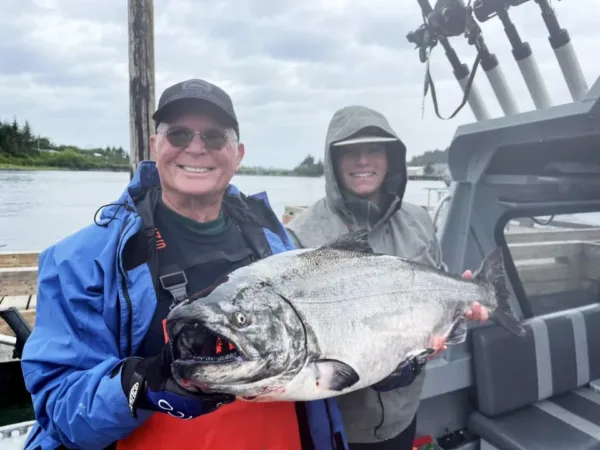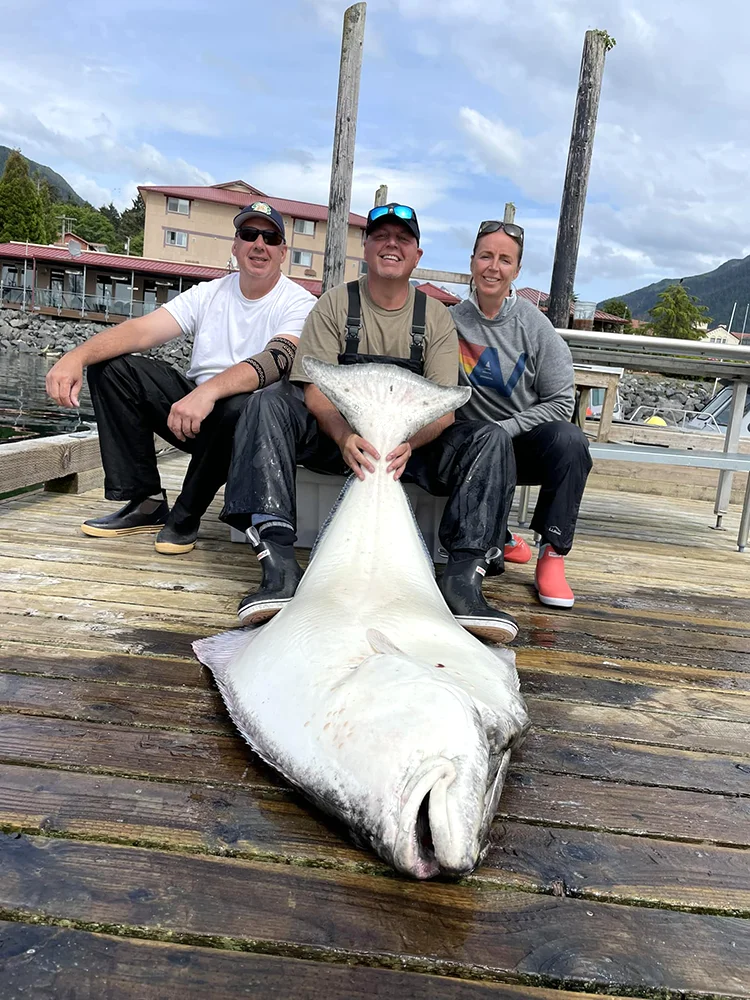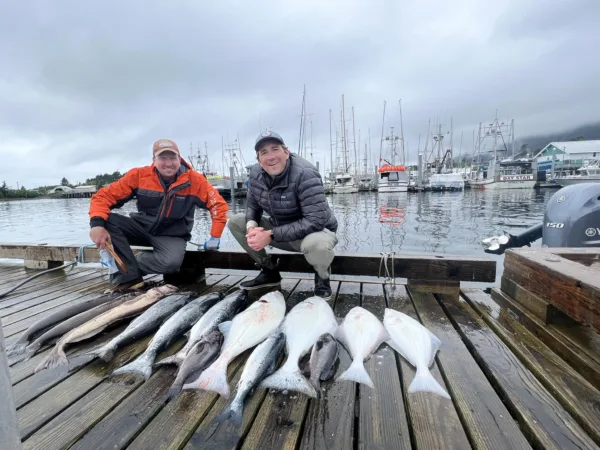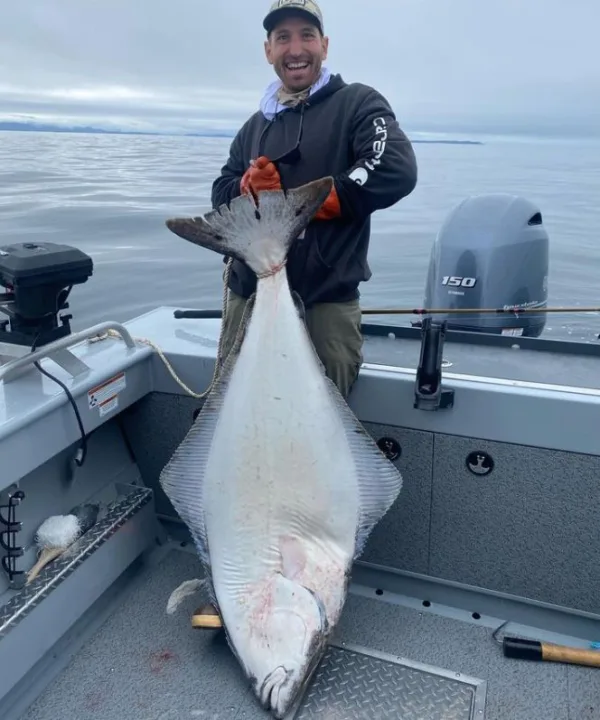The Sitka Fishing Report is intended to paint a seasonal picture of what and where anglers are catching fish in the Sitka area at different times of the year. Sitka is located on Baranof Island approximately midway on the Alaska Panhandle between Canada and Yakutat. Sitka Sound is somewhat protected and offers angling for all five Pacific salmon species native to North America. The Sound is also home to a plethora of tasty bottomfish including lingcod, various rockfish species, and halibut.
Fishing Sitka Sound
Outside of Sitka Sound, the open ocean can provide even hotter fishing for the same species. Massive numbers of feeding and migrating salmon from Alaska, British Columbia, Washington and Oregon pass by the entrance to Salisbury Sound, Cape Georgiana, Shelikof Bay, Cape Edgecumbe and Biorka Island on their way south towards their natal rivers. Halibut numbers are generally much better in the open ocean as well. The Sitka fishing report will cover all of these areas as reports come in. While fishing the open ocean in Alaska, weather is a factor, but when it’s right it’s not uncommon to find limits of salmon and bottomfish on a single day.
The Sitka Fishing Report will give you some ideas not only regarding where, but also when and how. Sitka Sound and the surrounding waters cover a large area. It can be somewhat overwhelming for those new to the area on a DIY trip to know where to go.
Latest Reports and Regulations
Regardless of whether fish are being caught inside the Sound, outside, or both, the Sitka Fishing Report will help you catch ‘em. The Sitka Fishing Report will be updated as often as new information or reports become available.
Fishing Regulations in the Sitka area are different than in other parts of Southeast. Be sure to check the regulations, including any Emergency Orders (EOs) that may have been issued recently. Current Sitka-area EOs can be found here.
August Fishing Report
This August fishing report covers the end of July through Mid-August 2023. Here is the latest out of Sitka.
Salmon
Fishing continues to be solid and steady in Sitka. King salmon angling remains really productive. Notably, there are some big fish being caught, with 25- to 30 pounders a real possibility. Lots of pinks and chums are still in the ocean, making for good numbers of hookups in general. Coho are here, and are certainly fat and happy. There’s some good sized ones around, and they are growing bigger by the day on the bounty of herring in the area.
Lingcod
In 2023 in the Northern Southeast Lingcod Area (where Sitka resides), Alaska residents are allowed 1 lingcod per day and 2 in possession with no size limits or annual limits. Nonresident fishermen are allowed 1 per day, 1 in possession, with an annual limit of 2 lingcod. Of the two annual lings, one can be 30-35 inches and one has to be 55 inches or greater in length. Lingcod have been fishing great for 30- to 35-inch slot-limit fish.


Halibut
Bottomfish angling remains good; halibut fishing has been phenomenal. The hot bait for us this year for halibut is really big, black-label herring. The oil content of these big baits rings the dinner bell for Sitka-area halibut.
Rockfish
Pelagic rockfish angling remains especially strong. Residents are allowed 4 per day, while nonresidents are allowed 2 per day. Common pelagic rockfish include black, blue, dark, dusky, widow and yellowtail.
Nonpelagic rockfish include canary, China, copper, quillback, rosethorn, tiger, and lastly, yelloweye. Yelloweye are closed to retention for all anglers. Resident anglers can keep 1 per day of the other available nonpelagic rockfish and nonresidents are not allowed to retain nonpelagic rockfish.
For any rockfish that you release, you’ll need to use a deepwater release mechanism to release fish at the depth they were caught or 100 feet, whichever is shallower. We’d recommend going to the depth they were caught.
Last month of 2023 Season
In recent weeks, anglers have caught both blue sharks and salmon sharks. Salmon sharks are particularly impressive, reaching huge sizes and looking like baby great white sharks. Unless an angler comes prepared to battle one, there’s little chance to land one. It takes heavy gear, big hooks and steel cable for leader. Nonetheless, just seeing one is worth the price of admission.
With one month left on our season, we can certainly say that it has been a really good year. Generally speaking, salmon fishing has been terrific, and bottomfish (halibut, lingcod and rockfish) angling has been as good as ever. All things considered, there’s a great chance you will catch a mixed bag of healthy fish when you rent a boat from Fish Baranof and fish the productive waters around Sitka. Check Sitka weather
Mid-Season Fishing Report
Fishing continues to be excellent in Sitka. King salmon fishing has been as good as it has been in the last few decades. Clients are bringing back lots of quality king salmon, with the occasional larger one hitting the dock. With good bait present in the area, primarily sand lance and small herring, salmon numbers remain strong.
Salmon
Coho salmon have begun to arrive, pretty early by our estimations. A dozen or so were brought in by our boats yesterday. Trolling herring and lures like Silver Horde Coho Killers, both pulled behind flashers, are yielding strong results for our fishermen. Chum salmon and pink salmon numbers are climbing, so anglers that are fishing Sitka in the upcoming weeks have a good chance to catch four of the five Pacific salmon species.
 Halibut
Halibut
Halibut stocks remain strong, and anglers are catching quality halibut everyday. Both bait and jig anglers are crushing it. Halibut are opportunistic predators and will attack a jig that gets near them. It pays to have a variety of jig styles with you so that you can find the one that the halibut react most favorably to; highliner halibut anglers typically carry a range of metal jigs with different actions, as well as lead head jigs with grub tails.
Ling Cod
Slot limit ling cod fishing has been excellent, with some anglers reporting that they are catching slot limit fish within a few drifts. Lings respond favorably to shiny things danced in front of their faces, so pounding reefs with metal is usually a winning strategy.
Rockfish
Black rockfish are abundant, and very much worth targeting. Yelloweye rockfish, as well as all non pelagic rockfish species, are closed to retention, so if you land one while prospecting for lings, or when halibut fishing, then be prepared to release it with a fish descender. It’s state regulation that you do this, so become acquainted with the gear and techniques to descend a non pelagic rockfish properly. (ADF&G regulations)
The fishing outlook for Sitka is extremely positive. Halibut, salmon, lingcod and rockfish are all being caught on our boats, and happy anglers are returning home with piles of fish and smiles for days. Stay tuned for another fishing report update later this season.
Contact us today for availability
Early 2023 Season

Sitka, Alaska Fishing Report
Sitka fishing is heating up. The king salmon season has been good so far, with a couple of 25-pounders having hit the dock recently. Halibut fishing has been excellent. Lingcod opened up mid-May and fishermen are catching these toothy predators. Rockfish angling has been solid so far.
King salmon are being caught on both the inside and outside coasts, with fish spread out everywhere and lots of feed. This makes it possible to find fish on windy days when it’s not possible to get to the outside waters. Ocean temperatures are good, and the sand lance are in thick, providing lots of food for area kings.
Warm spring looking ahead to summer

Sitka weather has been nice. We had an excellent spring with some warm weather so far. There’s good snow pack, so the water temperature should stay nice and cool throughout the summer. There are lots of fish around so far, and our clients have been having a heck of a time catching king salmon, halibut, lingcod, and rockfish. We should start seeing some early coho in the next few weeks.
The usual lures trolled behind flashers have been working for king salmon: Silver Horde Coho Killers and a variety of spoons are typically the best producers. Anglers are also experiencing success using herring and hoochies. Halibut fishing has been reliable, and fish numbers appear to be very good.
Bag Limits and Outlook
The annual limit for king salmon until July 1st is three kings (one per day). Our outlook for the next month is very positive for king salmon anglers. We’ve heard reports of several kings in the 35- to 40-pound range being caught. Unguided halibut anglers are allowed two halibut per day of any size, so our clients are catching quality fish daily. Non-pelagic rockfish are closed, so if you catch a non-pelagic rockfish species, you will beed to release it with the use of a descender. Pelagic rockfish species like black rockfish are abundant in Sitka-area waters, and that’s the one to target.
Fishing has been great so far, and so has the weather. Anglers are catching king salmon, halibut, lingcod and rockfish, enjoying good ocean conditions and great catching. We’ll report again next month on how the June fishing continues to unfold.

